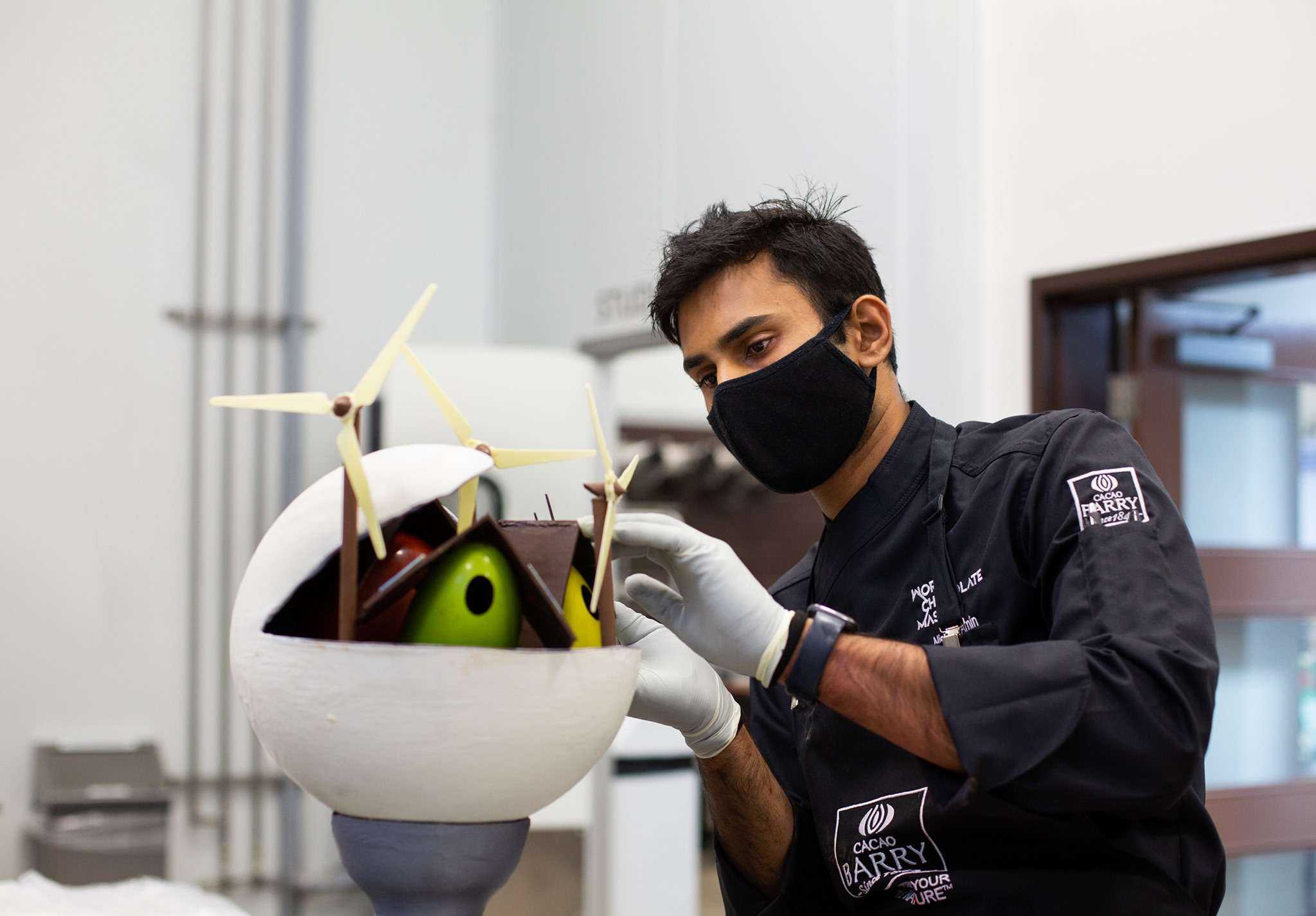BY JANIECE CAMPBELL
Toronto pastry chef Nishant Amin currently works at Richmond Station, where he concocts all sorts of visually-striking delicious treats daily from soft, pillowy croissants to sweet, sugary delights like lemon meringue pie.
His greatest confectionary talent, however? Chocolate.
On October 5th, 2021, Nishant was officially crowned the Canadian Chocolate Master! With this honour, he will jubilantly represent Canada at the Cacao Barry World Chocolate Masters final in Paris, France next year. Winning several categories in the competition, one of his many prized chocolatey creations was a snack inspired by his personal hiking endeavours, which consisted of a vegan brownie layered with peanut ganache and topped with nutty trail mix.
“I’m really proud to become the Canadian Chocolate Master. When they announced my name, I was so happy and overwhelmed. At that point, it felt so amazing to win the competition… but the next moment it was like oh wait I have to represent an entire country! That doubled up my happiness,” he says.
Nishant’s adoration for sweets wasn’t a part of the career he intended to follow. Originally, he imagined his life going down a different delectable path.
“Growing up, I was never into baking. I was more into cooking, so I decided to go to hospitality school and pursue being a savoury chef. I think by the time I was in third year, I realized that I loved chocolate and pastries – I literally fell in love with them! It was so fascinating at how a small bean could turn into a chocolate bar and how a grain becomes bread. I began working on my pastry skills and decided to become a pastry chef.”
After obtaining a bachelor’s degree in hospitality from the Institute of Hotel Management, Catering Technology and Applied Nutrition in Mumbai, India, Nishant decided to expand his horizons and look beyond his home country for work. Toronto appealed to him the most, and shortly after relocating, he achieved a diploma in Baking and Pastry Arts from George Brown College.
“In India, there was not enough openness about pastries. People weren’t looking for gourmet or fresh pastries. So that’s why I moved to Canada; I wanted to enhance my skills and see what new techniques and creations that chefs were doing. I wanted to learn from them.”
Nishant’s careful work ethic and unstoppable drive shines through in his delicacies, and people are often surprised to find out that he is a Type 1 diabetic, meaning that his body produces little to no insulin, resulting in difficulty regulating his blood sugar. This is a major obstacle particularly for a chef, where it’s customary to consistently taste the food as it flows out of the kitchen. A topic that often generates many questions, he uses his disease as an opportunity to teach and inspire others.
“There’s a lot of stigmas. People will often say it’s because I’m a pastry chef why I’m diabetic. Or that I shouldn’t be a pastry chef because I’m diabetic. I think those are the things where it’s important for me to educate them about Type 1 diabetes, where it’s not about sugar or your lifestyle, but it’s a chronic illness that you didn’t do anything to cause. It’s just how your body reacts,” says Nishant. “Even if I wasn’t a pastry chef, there are challenges in general. Because when you eat, what you eat, how much carbs, proteins, and fats you consume – they all account for each and every blood spike. In doing my daily job, part of it is tasting everything and if I see that I’ll be doing a lot of tasting in one day, I’ll give myself enough insulin to ensure my blood sugar will be regulated for the next couple of hours.”
As he prepares for the competition finals in October 2022, Nishant is rallying for the support of his community to help him cross the international finish line. He has set up a GoFundMe to assist in relieving the financial pressure of pricey medical expenses, travel costs and purchasing ingredients to continue practicing. As he continues to train and concentrate on building the finest chocolate sculptures, his prime focus is to reinforce a hopeful future on and off the world stage.
“When I think of this competition now, I’m not just internationally representing a country, I’m representing the diabetic community. The goal is to inspire people, and to show them to not be afraid of their disease no matter what. Though my creations are going to be with chocolate, they’re going to be tomorrow-forward, meaning creating healthier lifestyles and making better choices with chocolate in the future.”
Check out Nishant’s innovative and intricately designed cuisine @nichebaker on Instagram and please consider donating to the GoFundMe in his bio.

